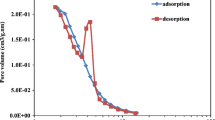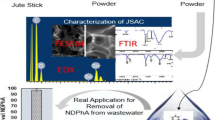Abstract
Polycyclic aromatic hydrocarbons are carcinogenic organic pollutants that are produced primarily by daily industrial and personal activities. This work studies the use of an abundant seagrass powder (SG) as an adsorbent to remove the relatively highly soluble PAHs (i.e., Acenaphthylene (Ace), Phenanthrene (Phen), and Flouranthene (Flu)) from contaminated water. At an optimum dose of 2 g/L, Flu was found to have the highest removal efficiency of 90.54%, followed by Phen with a removal efficiency of 87.89% and Ace with an efficiency of 61.11%. Flu had a maximum adsorption capacity of 2.25 mg/g at an equilibrium time of 6 h, followed by Phen with qe of 2.12 mg/g at an equilibrium time of 24 h, and finally Ace with qe of 1.13 mg/g at an equilibrium time of 120 h. Linear and non-linear isotherm Langmuir, Freundlich, and Temkin models fit largely well with adsorption data for Flu, Phen, and Ace. This suggests that coexistence of heterogeneous adsorption mechanism. The kinetic data of all 3 PAHs were best described by the pseudo-second-order model. The adsorption of both Flu and Phen by SG was observed to be spontaneous with negative ΔG values. On the other hand, the adsorption of Ace was spontaneous only at a low temperature. The change of enthalpy (ΔH) for all the studied compounds was negative; therefore, their adsorption was found to be exothermic. Physisorption appeared to dominate the adsorption mechanism of Flu and Phen, with ΔH values of − 36.03 kJ/mol and − 36.65 kJ/mol respectively. However, Ace adsorption showed some presence of chemisorption, with ΔH values of − 114.43 kJ/mol.







Similar content being viewed by others
References
Akinpelu AA, Ali ME, Johan MR, Saidur R, Qurban MA, Saleh TA (2019) Polycyclic aromatic hydrocarbons extraction and removal from wastewater by carbon nanotubes: a review of the current technologies, challenges and prospects. Process Saf Environ Prot 122:68–82. https://doi.org/10.1016/J.PSEP.2018.11.006
Marczynski B et al (2009) Occupational exposure to polycyclic aromatic hydrocarbons and DNA damage by industry: a nationwide study in Germany. Arch Toxicol.https://doi.org/10.1007/s00204-009-0444-9
Sharma A, Siddiqi Z-M, Pathania D (2017) Adsorption of polyaromatic pollutants from water system using carbon/ZnFe2O4 nanocomposite: equilibrium, kinetic and thermodynamic mechanism. J Mol Liq 240:361–371. https://doi.org/10.1016/J.MOLLIQ.2017.05.083
Akinpelu AA et al (2020) A support vector regression model for the prediction of total polyaromatic hydrocarbons in soil: an artificial intelligent system for mapping environmental pollution. Neural Comput Appl.https://doi.org/10.1007/s00521-020-04845-3
Keshavarzifard M, Zakaria MP, Hwai TS (2017) Bioavailability of polycyclic aromatic hydrocarbons (PAHs) to short-neck clam (Paphia undulata) from sediment matrices in mudflat ecosystem of the west coast of Peninsular Malaysia. Environ Geochem Health.https://doi.org/10.1007/s10653-016-9835-z
Wang W-D, Huang Y-M, Shu W-Q, Cao J (2007) Multiwalled carbon nanotubes as adsorbents of solid-phase extraction for determination of polycyclic aromatic hydrocarbons in environmental waters coupled with high-performance liquid chromatography. J Chromatogr A 1173(1–2):27–36. https://doi.org/10.1016/j.chroma.2007.10.027
Akinpelu AA et al (2019) Effect of the oxidation process on the molecular interaction of polyaromatic hydrocarbons (PAH) with carbon nanotubes: adsorption kinetic and isotherm study. J Mol Liq 111107. https://doi.org/10.1016/J.MOLLIQ.2019.111107
Bianco F, Race M, Papirio S, Esposito G (2020) Removal of polycyclic aromatic hydrocarbons during anaerobic biostimulation of marine sediments. Sci Total Environ 709. https://doi.org/10.1016/j.scitotenv.2019.136141
Bhadra BN, Song JY, Lee SK, Hwang YK, Jhung SH (2018) Adsorptive removal of aromatic hydrocarbons from water over metal azolate framework-6-derived carbons. J Hazard Mater 344:1069–1077. https://doi.org/10.1016/j.jhazmat.2017.11.057
Qurban MAB, Karuppasamy M, Krishnakumar PK, Garcias-Bonet N, Duarte CM (2019) Seagrass distribution, composition and abundance along the Saudi Arabian coast of Red Sea. In: Rasul N, Stewart I (eds) Oceanographic and biological aspects of the Red Sea. Springer Oceanography. Springer, Cham. https://doi.org/10.1007/978-3-319-99417-8_20
Georgios A, Maria B, Constantinos S, Bourlinos AB, Zboril R, Karakassides MA (2020) Advanced Cr(VI) sorption properties of activated carbon produced via pyrolysis of the ‘Posidoniaoceanica’ seagrass. J Hazard Mater.https://doi.org/10.1016/j.jhazmat.2020.124274
Elmorsi RR et al (2019) Adsorption of methylene blue and Pb 2+ by using acid-activated Posidoniaoceanica waste. Sci Rep.https://doi.org/10.1038/s41598-019-39945-1
Photiou P, Koutsokeras L, Constantinides G, Koutinas M, Vyrides I (2021) Phosphate removal from synthetic and real wastewater using thermally treated seagrass residues of Posidonia oceanica. J Clean Prod.https://doi.org/10.1016/j.jclepro.2020.123294
Rengarajan T, Rajendran P, Nandakumar N, Lokeshkumar B, Rajendran P, Nishigaki I (2015) Asian Pacific Journal of Tropical Biomedicine. Asian Pac J Trop Biomed 5(3):182–189. https://doi.org/10.1016/S2221-1691(15)30003-4
Viena V, Elvitriana, Nizar M (2019) Characterization of activated carbon prepared from banana peels: effect of chemical activators on the adsorption of gas emissions. J Phys: Conf Ser 1232:012005
Ololade IA et al (2018) In-situ modification of soil organic matter towards adsorption and desorption of phenol and its chlorinated derivatives. J Environ Chem Eng 6:2. https://doi.org/10.1016/j.jece.2018.05.034
Muendo BM, Shikuku VO, Getenga ZM, Lalah JO, Wandiga SO, Rothballer M (2021) Adsorption-desorption and leaching behavior of diuron on selected Kenyan agricultural soils. Heliyon 7:2. https://doi.org/10.1016/j.heliyon.2021.e06073
Nazal MK, Gijjapu D, Abuzaid N. First investigations on removal of nitrazepam from water using biochar derived from macroalgae low-cost adsorbent: kinetics, isotherms and thermodynamics studies. Water Pract Technol wpt2021040. https://doi.org/10.2166/wpt.2021.040
Akinpelu AA et al (2021) Adsorption studies of volatile organic compound (naphthalene) from aqueous effluents: chemical activation process using weak lewis acid, equilibrium kinetics and isotherm modelling. Int J Mol Sci 22:4. https://doi.org/10.3390/ijms22042090
Allen SJ, Gan Q, Matthews R et al (2003) Comparison of optimised isotherm models for basic dye adsorption by kudzu. Bioresour Technol 88(2):143–152
Adeola AO, Forbes PBC (2020) Assessment of reusable graphene wool adsorbent for the simultaneous removal of selected 2–6 ringed polycyclic aromatic hydrocarbons from aqueous solution. Environ Technol (UK).https://doi.org/10.1080/09593330.2020.1824024
Nazal MK, Gijjapu D, Abuzaid N (2020) Study on adsorption performance of 2,4,6-trichlorophenol from aqueous solution onto biochar derived from macroalgae as an efficient adsorbent. Sep Sci Technol.https://doi.org/10.1080/01496395.2020.1815778
Eeshwarasinghe D, Loganathan P, Kalaruban M et al (2018) Removing polycyclic aromatic hydrocarbons from water using granular activated carbon: kinetic and equilibrium adsorption studies. Environ Sci Pollut Res 25:13511–13524. https://doi.org/10.1007/s11356-018-1518-0
Zhang C et al (2013) Adsorption of polycyclic aromatic hydrocarbons (fluoranthene and anthracenemethanol) by functional graphene oxide and removal by pH and temperature-sensitive coagulation. ACS Appl Mater Interfaces. https://doi.org/10.1021/am4002666
Sodaitienė E et al (2021) Sustainable removal of anodized aluminum dye by groundwater treatment waste: experimental and modeling. Heliyon 7:1. https://doi.org/10.1016/j.heliyon.2021.e05993
Dehghani MH et al (2020) Statistical modelling of endocrine disrupting compounds adsorption onto activated carbon prepared from wood using CCD-RSM and DE hybrid evolutionary optimization framework: comparison of linear vs non-linear isotherm and kinetic parameters. J Mol Liq 302. https://doi.org/10.1016/j.molliq.2020.112526
Maamoun I, Eljamal R, Falyouna O, Bensaida K, Sugihara Y, Eljamal O (2021) Insights into kinetics, isotherms and thermodynamics of phosphorus sorption onto nanoscale zero-valent iron. J Mol Liq 328:115402. https://doi.org/10.1016/j.molliq.2021.115402
Veloso CH, Filippov LO, Filippova IV, Ouvrard S, Araujo AC (2020) Adsorption of polymers onto iron oxides: equilibrium isotherms. J Mater Res Technol 9:1. https://doi.org/10.1016/j.jmrt.2019.11.018
Feng X, Simpson AJ, Simpson MJ (2005) Chemical and mineralogical controls on humic acid sorption to clay mineral surfaces. Org Geochem 36:11. https://doi.org/10.1016/j.orggeochem.2005.06.008
Arnarson TS, Keil RG (2000) Mechanisms of pore water organic matter adsorption to montmorillonite. Mar Chem 71:3–4. https://doi.org/10.1016/S0304-4203(00)00059-1
Yavari S, Sapari NB, Malakahmad A, Bin Razali MA, Gervais TS, Yavari S (2020) Adsorption–desorption behavior of polar imidazolinone herbicides in tropical paddy fields soils. Bull Environ Contam Toxicol 104:1. https://doi.org/10.1007/s00128-019-02759-y
Tong H, Hu X, Zhong X, Jiang Q (2021) Adsorption and desorption of triclosan on biodegradable polyhydroxybutyrate microplastics. Environ Toxicol Chem 40:1. https://doi.org/10.1002/etc.4902
Wang J, Chen Z, Chen B (2014) Adsorption of polycyclic aromatic hydrocarbons by graphene and graphene oxide nanosheets. Environ Sci Technol 48(9):4817–4825. https://doi.org/10.1021/es405227u
Wu W, Chen W, Lin D, Yang K (2012) Influence of surface oxidation of multiwalled carbon nanotubes on the adsorption affinity and capacity of polar and nonpolar organic compounds in aqueous phase. https://doi.org/10.1021/es3004848.
Yuan M, Tong S, Zhao S, Jia CQ (2010) Adsorption of polycyclic aromatic hydrocarbons from water using petroleum coke-derived porous carbon. J Hazard Mater.https://doi.org/10.1016/j.jhazmat.2010.05.130
Huang Y et al (2018) Reduced graphene oxide-hybridized polymeric high-internal phase emulsions for highly efficient removal of polycyclic aromatic hydrocarbons from water matrix. Langmuir.https://doi.org/10.1021/acs.langmuir.8b00005
Esfandiar N, Suri R, McKenzie ER (2021) Simultaneous removal of multiple polycyclic aromatic hydrocarbons (PAHs) from urban stormwater using low-cost agricultural/industrial byproducts as sorbents. Chemosphere.https://doi.org/10.1016/j.chemosphere.2021.129812
Wang C et al (2021) The preparation of porosity modified porous organic frameworks via kaolin loading and its improved aromatic organic compounds removal performance. Microporous Mesoporous Mater 315. https://doi.org/10.1016/j.micromeso.2020.110855.
Gupta H, Singh S (2018) Kinetics and thermodynamics of phenanthrene adsorption from water on orange rind activated carbon. Environ TechnolInnov.https://doi.org/10.1016/j.eti.2018.03.001
Okoli CP, Adewuyi GO, Zhang Q, Zhu G, Wang C, Guo Q (2015) Aqueous scavenging of polycyclic aromatic hydrocarbons using epichlorohydrin, 1,6-hexamethylene diisocyanate and 4,4-methylene diphenyl diisocyanate modified starch: Pollution remediation approach. Arab J Chem (November). https://doi.org/10.1016/j.arabjc.2015.06.004.
Author information
Authors and Affiliations
Corresponding author
Ethics declarations
Conflict of interest
The authors declare no competing interests.
Additional information
Publisher’s note
Springer Nature remains neutral with regard to jurisdictional claims in published maps and institutional affiliations.
Supplementary information
Below is the link to the electronic supplementary material.
Rights and permissions
About this article
Cite this article
Akinpelu, A.A., Nazal, M.K. & Abuzaid, N. Adsorptive removal of polycyclic aromatic hydrocarbons from contaminated water by biomass from dead leaves of Halodule uninervis: kinetic and thermodynamic studies. Biomass Conv. Bioref. 13, 8301–8313 (2023). https://doi.org/10.1007/s13399-021-01718-0
Received:
Revised:
Accepted:
Published:
Issue Date:
DOI: https://doi.org/10.1007/s13399-021-01718-0




